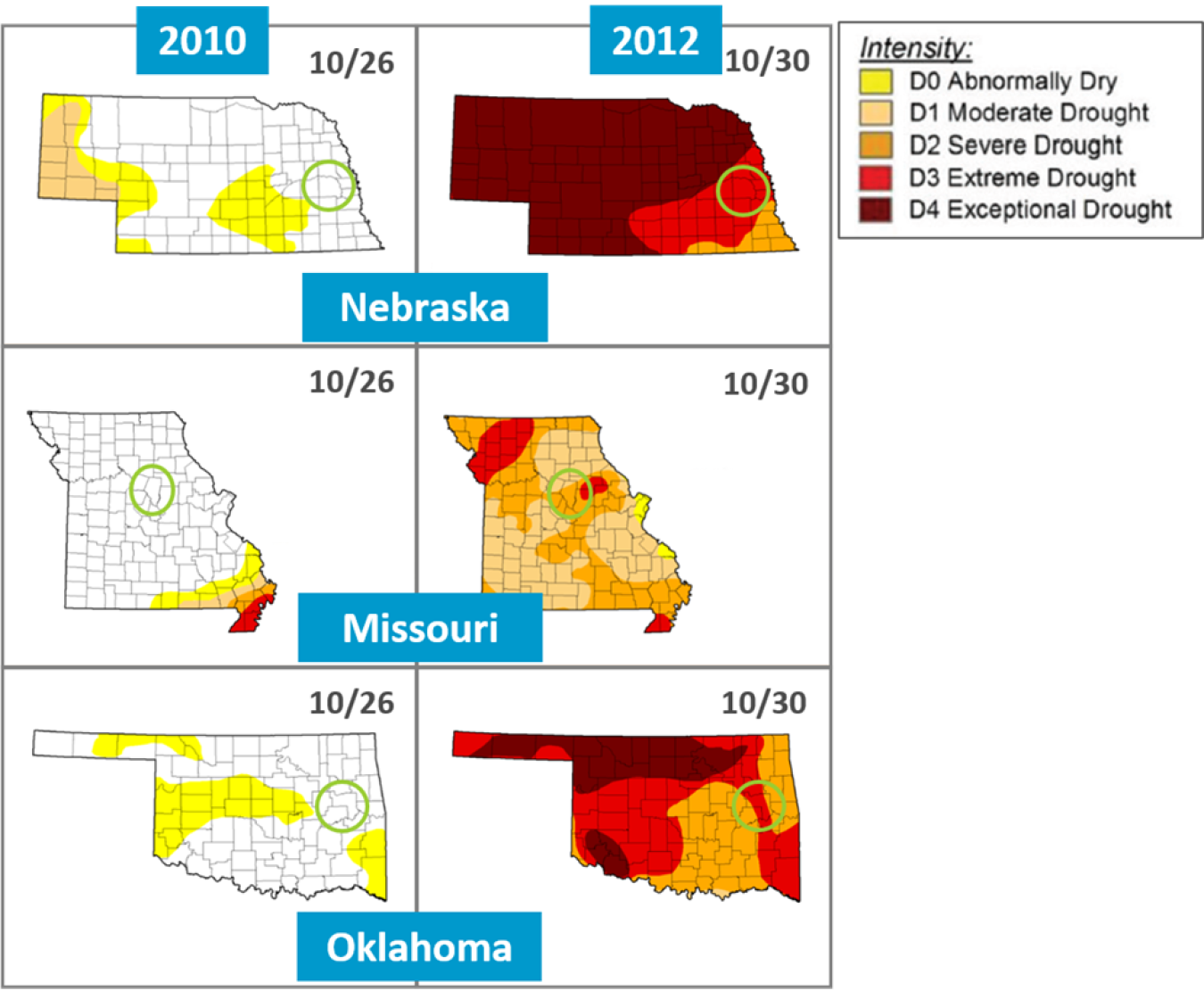As the U.S. Department of Energy helps biorefining companies convert grasses, crop residue, and forest byproducts into alternative fuels and advanced manufacturing materials, year-to-year chemical changes caused by climate volatility have become a...
January 24, 2023
Author: Dr. Lynn Wendt, Laboratory Relationship Manager, Idaho National Laboratory
Read Lynn's bio ►
Meet the other bloggers ►
Return to Bioprose blog ►
As the U.S. Department of Energy (DOE) supports research, development, and demonstration to enable conversion of grasses, crop residue, and forest byproducts into alternative fuels and advanced manufacturing materials, year-to-year chemical changes caused by climate volatility have become a growing concern. Examining the differences in biomass samples from 2010, a normal year, and the drought year of 2012, researchers from Idaho National Laboratory (INL) have set out to identify what drought does to biomass chemistry and what adjustments might be needed in the processing and production of drought-impacted biomass.
While it has always been known that drought can affect biomass yields and production costs, extreme swings and unpredictability in weather, especially in the American Midwest, are raising new questions. In the 2021 Regional Feedstock Partnership Biomass Quality Assessment Final Report, the INL-led team has produced an assessment of what effect variable environmental conditions can have on the chemical properties of Miscanthus, switchgrass, sorghum, energy cane, mixed perennial grasses, and short-rotation woody feedstocks such as shrub willow.
A Wealth of Information
DOE’s Bioenergy Technologies Office (BETO) announced its Billion Ton Vision in 2005, which provides a roadmap of how one billion tons of biomass might be produced for the bioenergy industry by 2030. The Regional Feedstock Partnership and subsequent Bioenergy Feedstock Library were created to help reach the Billion Ton Vision. For years, DOE’s Bioenergy Feedstock Library, hosted at INL, has been accumulating biomass samples. Today, the library stores and tracks metadata and analytical data on more than 70,000 samples, making it one of the largest bioenergy resource data repositories in the world.
Year-to-year chemical changes in biomass came into sharp focus when the biomass data from 2012, the year drought affected 65% of the country, was compared to biomass data from the same locations in 2010, a non-drought year.

Drought conditions at the end of October in 2010 and 2012 for Nebraska, Missouri, and Oklahoma. Credit Source: Frontiers in Energy Research, article authors: A. Hoover, et al.
Three Species, Three Climates
For each of the three species—Miscanthus grown in Nebraska, a tall fescue mixture harvested from Missouri, and switchgrass grown in Oklahoma—three aspects were considered to determine the location-specific drought conditions and the drought stress reactions for each of the biomass types. Precipitation and temperature trends during the growing season had to be considered, as plants that experience drought conditions can recover if favorable conditions return before harvest. Second, chemical changes, including multiple types of compatible solutes, structural components, and inorganic elements, were assessed. Structural components such as structural sugars and lignin, a component that makes cell walls rigid, are critical for understanding biomass value to a biorefinery. Last, conversion efficiencies and calculated theoretical ethanol yields were used to determine each sample's reaction to drought and to estimate the overall impact on a bioconversion process.
Overall, the results of the study indicated that drought has the potential not only to decrease dry-biomass yield, but also to alter biomass chemical composition. The Miscanthus results demonstrated that while it may lose structural sugars during drought, due to lower recalcitrance components, remaining sugars are more readily available for conversion. Compatible solutes include small groups of molecules capable of moving through cell membranes and have been shown to accumulate in plant cells in response to drought. The tall fescue mixture collected after drought had higher concentrations of the compatible solute proline (amino acid), lower structural sugars, and lower dry biomass yield, but minimal significant differences in sugar release following dilute-acid pretreatment and enzymatic hydrolysis in samples; however, this result could have been due to less severe drought conditions at the field site. Few differences were observed for switchgrass composition and conversion performance, possibly because of its tolerance to drought or the conditions at the field site during 2010 and 2012.
Careful Selection and Pretreatment
The researchers observed that drought-induced changes may decrease the efficiency of the biochemical conversion process. This drives home the need for careful selection of pretreatment methodology based on location and biomass used. In addition, research and development is necessary to support breeding programs to produce bioenergy cultivars with traits like increased water use efficiency.
An advanced supply system can reduce operating risk by supplying a refinery with more consistent biomass amounts year to year, but a refinery may still receive feedstock with varying quality. With in-line monitoring techniques, biomass or process intermediates could be blended to meet process specifications or adjust pretreatment severity to minimize the degradation of soluble components generated during drought stress.
The studies capitalized on samples collected as part of the Regional Feedstock Partnership, an initiative started in 2007 by DOE and the Sun Grant Institute to address the potential barriers to a reliable supply of materials for a large-scale biorefining industry. If biomass yields are low due to drought in the region or the feedstock that arrives at a biorefinery is substandard the plant cannot run at full capacity. For management, this means less production and higher costs. To cope, management must seek out additional sources of feedstock supply, and because additional supply is not covered by contracts that managers have with growers for the initial supply, additional material is likely to be more expensive.
If the nation is to meet its goal of producing 35 billion gallons of aviation fuel by 2050, set forth in the Sustainable Aviation Fuel Grand Challenge, the effects of drought are a risk that must be addressed. To the authors' knowledge, these were the first studies investigating the impact of drought on dilute-acid pretreatment and enzymatic hydrolysis of biomass.
For More Information
In the book chapter Drought Impacts on Bioenergy Supply System Risk and Biomass Composition (IntechOpen, 2019), Amber Hoover, Rachel Emerson, Jason Hansen, Damon Hartley and Allison Ray examined how drought-related risks can affect biorefining supply chains and proposed strategies for the thoughtful design of logistics systems. In their 2018 Frontiers in Energy Research article, Impact of Drought on Chemical Composition and Sugar Yields from Dilute Acid Pretreatment and Enzymatic Hydrolysis of Miscanthus, a Tall Fescue Mixture, and Switchgrass, they explore in detail the complex physiological and biochemical responses that affect recalcitrance—the ability of plant cell walls to resist chemical and biological deconstruction—and conversion performance.
Dr. Lynn Wendt

Dr. Lynn Wendt serves as the Laboratory Relationship Manager to the U.S. Department of Energy’s Bioenergy Technologies Office (BETO). Dr. Wendt is also a senior research scientist in the Energy and Environment Science and Technology Directorate at Idaho National Laboratory (INL). She has served as a principal investigator for multiple projects sponsored by BETO and has contributed to strategic planning for INL’s Biomass Feedstock National User Facility and associated programs. Dr. Wendt holds a bachelor’s degree in biochemistry from the University of Minnesota, a master's in biology from Idaho State University, and a Ph.D. in environmental science from the University of Idaho. Dr. Wendt is a bioenergy research expert in post-harvest physiology and chemistry of biomass storage systems and microbial systems for bioenergy feedstock supply chain processes. She has pioneered the development of biomass and algae material storage and handling systems that stabilize biomass materials while increasing biomass value during short- and long-term storage. Her 25 biomass-related publications and 3 patent applications are the authoritative reference on value-add biomass storage systems.


